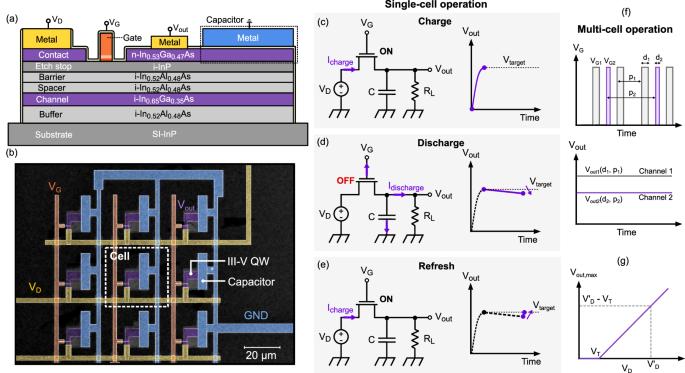Cryogenic quantum computer control signal generation using high-electron-mobility transistors
引用次数: 0
Abstract
Multiplexed local charge storage, close to quantum processors at cryogenic temperatures could generate a multitude of control signals, for electronics or qubits, in an efficient manner. Such cryogenic electronics require generating quasi-static control signals with small area footprint, low noise, high stability, low power dissipation and, ideally, in a multiplexed fashion to reduce the number of input/outputs. In this work, we integrate capacitors with cryogenic high-electron mobility transistor (HEMT) arrays and demonstrate quasi-static bias generation using gate pulses controlled in time and frequency domains. Multi-channel bias generation is also demonstrated. Operation at 4 K exhibits improved bias signal variability and greatly reduced subthreshold swing, reaching values of ~6 mV/decade. Due to the very low threshold voltage of 80 mV at 4 K and the steep subthreshold swing, these circuits can provide an advantage over the silicon-based complementary metal-oxide-semiconductor equivalents by allowing operation at significantly reduced drive bias in the low output voltage regime <1 V. Together with their high-speed operation, this makes HEMTs an attractive platform for future cryogenic signal generation electronics in quantum computers. Alberto Ferraris and colleagues demonstrate a cryogenic circuit with a InGaAs-based quantum well transistors integrated with capacitors for the application of quantum computers. This system improves over Si CMOS by superior properties at cryogenic temperature and with a lower voltage supply, which is helpful to reduce the power consumption in the qubit control applications.

利用高电子迁移率晶体管生成低温量子计算机控制信号
在低温条件下,接近量子处理器的多路复用本地电荷存储可以高效地为电子器件或量子比特生成大量控制信号。这种低温电子设备要求生成的准静态控制信号占用面积小、噪声低、稳定性高、功耗低,而且最好能以多路复用的方式减少输入/输出的数量。在这项工作中,我们将电容器与低温高电子迁移率晶体管(HEMT)阵列集成在一起,并利用时域和频域控制的栅极脉冲演示了准静态偏置生成。此外,还演示了多通道偏压产生。在 4 K 下运行时,偏置信号的可变性得到改善,阈下摆动大大降低,达到约 6 mV/decade。由于这些电路在 4 K 时的阈值电压非常低,仅为 80 mV,而且阈下摆幅很陡,因此与硅基互补金属氧化物半导体等效电路相比,它们具有更大的优势,可以在低输出电压范围 <1 V 条件下以显著降低的驱动偏置运行。HEMT 的高速运行特性使其成为量子计算机中未来低温信号生成电子器件的理想平台。Alberto Ferraris 及其同事展示了一种低温电路,该电路采用基于 InGaAs 的量子阱晶体管,并集成了用于量子计算机的电容器。与硅 CMOS 相比,该系统在低温条件下具有更优越的性能,而且供电电压更低,有助于降低量子比特控制应用中的功耗。
本文章由计算机程序翻译,如有差异,请以英文原文为准。
求助全文
约1分钟内获得全文
求助全文

 求助内容:
求助内容: 应助结果提醒方式:
应助结果提醒方式:


